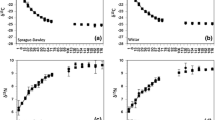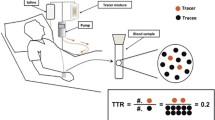Abstract
The reaction progress variable is applied to stable isotope turnover of biological tissues. This approach has the advantage of readily determining whether more than one isotope turnover pool is present; in addition, the normalization process inherent to the model means that multiple experiments can be considered together although the initial and final isotope compositions are different. Consideration of multiple isotope turnover pools allows calculation of diet histories of animals using a time sequence of isotope measurements along with isotope turnover pools. The delayed release of blood cells from bone marrow during a diet turnover experiment can be quantified using this approach. Turnover pools can also be corrected for increasing mass during an experiment, such as when the animals are actively growing. Previous growth models have been for exponential growth; the approach here can be used for several different growth models.







Similar content being viewed by others
References
Ayliffe LK, Cerling TE, Robinson T, West AG, Sponheimer M, Passey BH, Hammer J, Roeder B, Dearing MD, Ehleringer JR (2004) Turnover of carbon isotopes in tail hair and breath CO2 of horses fed an isotopically varied diet. Oecologia 139:11–22
Cerling TE, Harris JM (1999) Carbon isotope fractionation between diet and bioapatite in ungulate mammals and implications for ecological and paleoecological studies. Oecologia 120:347–363
Cerling TE, Viehl K (2004) Seasonal diet changes of the giant forest hog (Hylochoerus meinertzhagani Thomas) based on the carbon isotopic composition of hair. Afr J Ecol 42:88–92
Cerling TE, Passey BH, Ayliffe LK, Cook CS, Ehleringer JR, Harris JM, Dhidha MB, Kasiki SM (2004) Orphans’ tales: seasonally dietary changes in elephants from Tsavo National Park, Kenya. Palaeogeogr Palaeoclim Palaeoecol 206:367–376
Cerling TE, Wittemyer G, Rasmussen HB, Vollrath F, Cerling CE, Robinson TJ, Douglas-Hamilton I (2006) Stable isotopes in elephant hair documents migration patterns and diet changes. Proc Natl Acad Sci 103:371–373
Criss RE (1999) Principles of stable isotope distribution. Oxford Press, Oxford, p 254
Criss RE, Gregory RT, Taylor HP (1987) Kinetic theory of oxygen isotope exchange between minerals and water. Geochim Cosmochim Acta 51:1099–1108
Friedlander G, Kennedy JW, Macias ES, Miller JM (1981) Nuclear and radiochemistry. Wiley, New York, p 684
Fry B, Arnold C (1982) Rapid 13C/12C turnover during growth of brown shrimp (Penaeus aztecus). Oecologia 54:200–204
Hesslein RH, Hallard KA, Ramal P (1993) Replacement of sulfur, carbon, and nitrogen in tissue of growing broad whitefish (Coregonus nasus) in response to a change in diet traced by δ34S, δ13C, and δ15N. Can J Fish Aquat Sci 50:2071–2076
Hobson KA, Clark RG (1992) Assessing avian diets using stable isotopes. I. Turnover of 13C in tissues. Condor 94:181–188
Hobson KA, Clark RG (1993) Turnover of 13C in cellular and plasma fractions of blood: implications for nondestructive sampling in avian dietary studies. Auk 110:648–641
Overman RT, Clark HM (1960) Radioisotope techniques. McGraw-Hill, New York, p 476
Passey BH, Robinson TF, Ayliffe LK, Cerling TE, Sponheimer M, Dearing MD, Roeder BL, Ehleringer JR (2005) Carbon isotopic fractionation between diet, breath, and bioapatite in different mammals. J Archaeol Sci 32:1459–1470
Podlesak DW, McWilliams SR, Hatch KA (2005) Stable isotopes in breath, blood, feces and feathers can indicate intra-individual changes in the diet of migratory songbirds. Oecologia 142:501–510
Simon O (1989) Metabolism of proteins and amino acids. In: Bock HD, Eggum BO, Low AG, Simon O, Zebrowska T (eds) Protein metabolism in farm animals. Evaluation, digestion, adsorption, and metabolism. Oxford University Press, Oxford, pp 273–363
Sponheimer J, Robinson T, Ayliffe L, Roeder B, Shipley L, Lopez E, West A, Hammer J, Passey B, Cerling T, Dearing D, Ehleringer J (2003) An experimental study of carbon isotopes in the diets, feces and hair of mammalian herbivores. Can J Zool 81:871–876
Suzuki KW, Kasai A, Nakayama K, Tanaka M (2005) Differential isotopic enrichment and half-life amoung tissues in Japanese temperate bass (Lateolabrax japonicus) juveniles: implications for analyzing migration. Can J Fish Aquat Sci 62:671–678
Thompson RC (1952a) Studies of metabolic turnover with tritium as a tracer. I. Gross studies on the mouse. J Biol Chem 197:81–87
Thompson RC (1952b) Studies of metabolic turnover with tritium as a tracer. II. Gross studies on the rat. J Biol Chem 200:731–743
Thompson RC, Ballou JE (1956) Studies of metabolic turnover with tritium as a tracer. V. The predominantly non-dynamic state of body constituents in the rat. J Biol Chem 214:795–809
Tieszen LL, Fagre T (1993) Effect of diet quality and composition on the isotopic composition of respiratory CO2, bone collagen, bioapatite, and soft tissues. In: Lambert JB, Grupe G (eds) Prehistoric human bone-archaeology at the molecular level. Springer-Verlag, Berlin, pp 121–155
Tieszen LL, Boutton TW, Tesdahl KG, Slade NA (1983) Fractionation and turnover of stable carbon isotopes in animal tissues: implications for δ13C analyses of diet. Oecologia 57:32–37
Trueman CN, McGill RAR, Guyard PH (2005) The effect of growth rate on tissue-diet isotope spacing in rapidly growing animal. An experimental study with Atlantic salmon (Salmo salar). Rapid Commun Mass Spectrom 29:3239–3247
West AG, Ayliffe LK, Cerling TE, Robinson TF, Karren B, Dearing MD, Ehleringer JR (2004) Short-term diet changes revealed using stable carbon isotopes in horse tail-hair. Funct Ecol 18:616–624
Acknowledgements
This work was partially funded by IsoForensics; T. E. C. and J. R. E. have financial ties to IsoForensics. We are grateful for the support provided by the SIRFER laboratory at the University of Utah. The work on woodrats was supported by NSF grant IN0236402 to M. D. D. We thank Brian Popp, Don Phillips, and an anonymous reviewer for useful comments.
Author information
Authors and Affiliations
Corresponding author
Additional information
Communicated by Todd Dawson.
Electronic supplementary material
Excel file that contains worksheets for comparing multiple pools, diet histories, isotope effects due to mass increase.
Rights and permissions
About this article
Cite this article
Cerling, T.E., Ayliffe, L.K., Dearing, M.D. et al. Determining biological tissue turnover using stable isotopes: the reaction progress variable. Oecologia 151, 175–189 (2007). https://doi.org/10.1007/s00442-006-0571-4
Received:
Accepted:
Published:
Issue Date:
DOI: https://doi.org/10.1007/s00442-006-0571-4




